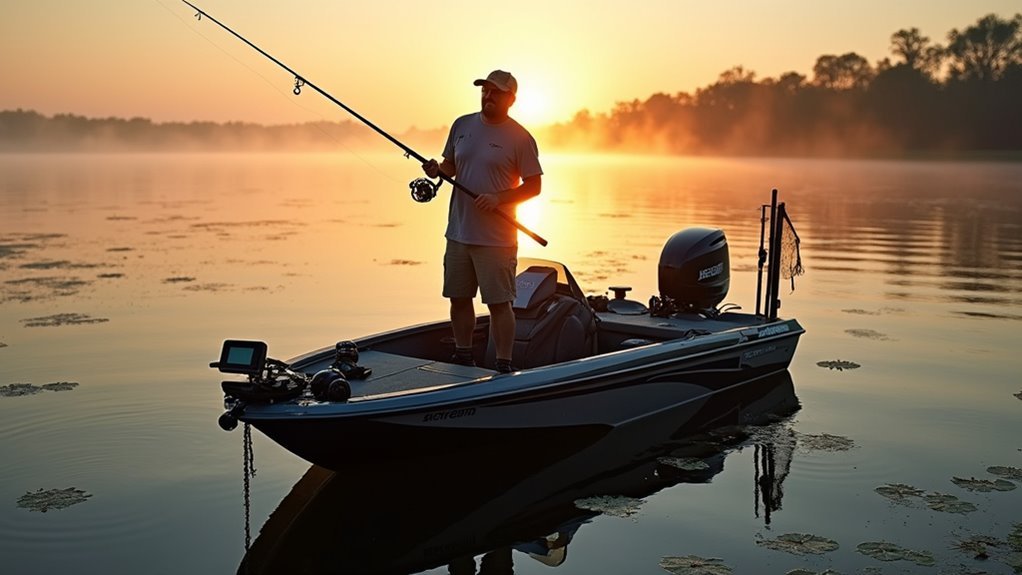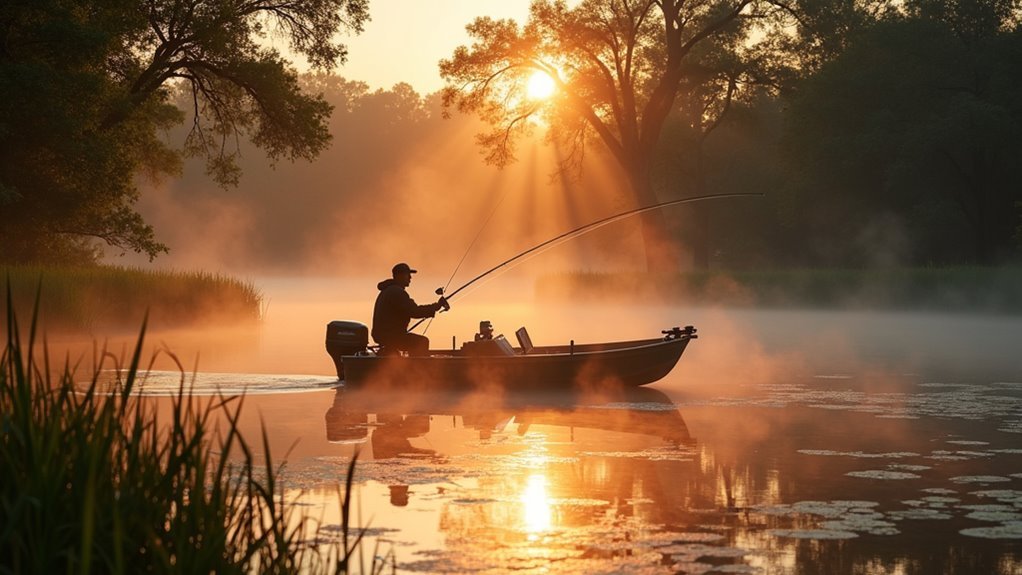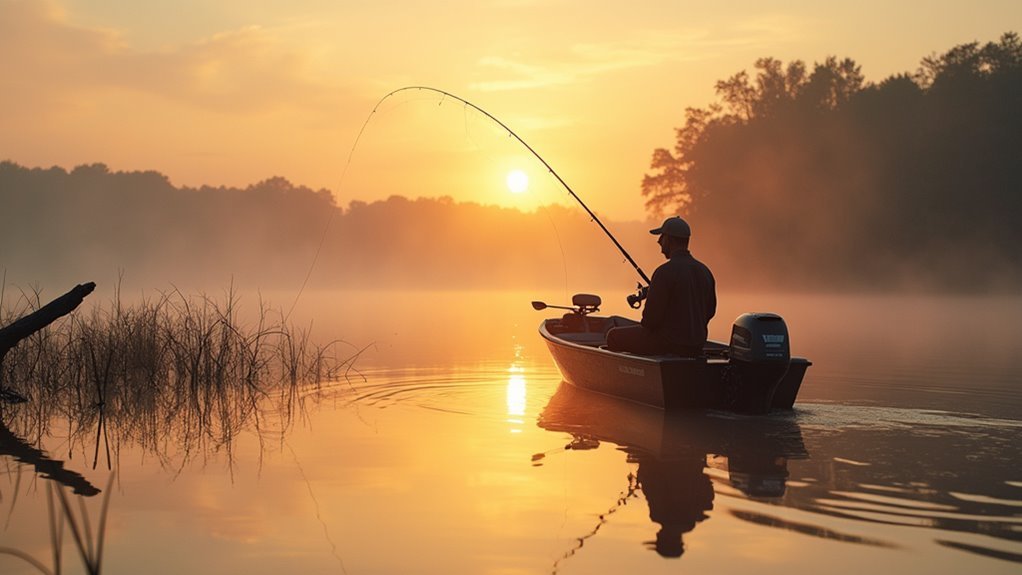To master big bass fishing, we need specialized gear like heavy-duty rod-reel combos and 10-pound line. We’ll target 10-foot water depths where lunkers hide in thick vegetation and mucky areas. For best results, we’ll fish during late morning, slow down our presentations, and focus on overgrown ponds that others overlook. Patience is key—those slow twitches in the strike zone trigger monster hits when smaller bass have already fed. The secrets of consistent trophy catches await below.
Essential Equipment for Targeting Trophy Bass

Anglers dream of that heart-stopping moment when a monster bass breaks the water’s surface, tail thrashing and gills flaring. To make this dream a reality, we need the right gear.
We’ve learned the hard way that standard equipment just won’t cut it for trophy bass. Invest in a heavy-duty casting rod and reel combo that can handle fish over 5 pounds. Pair it with quality 10-pound monofilament line for flexibility and better hooksets. Additionally, consider enhancing your fishing experience with a trolling motor that provides quiet and efficient movement, allowing you to stealthily approach your fishing spot.
Selecting the Right Locations to Find Monster Bass

Where do those giant, jaw-dropping bass hide when you’re not looking? They’re lurking in the depths, typically around 10-foot water levels, nestled in thick vegetation and mucky areas that most anglers avoid.
We’ve found our biggest catches not in open water, but near structure—banks, dams, and especially in those overgrown, weedy ponds that don’t see much fishing pressure. Once, we cast deep into what looked like an impenetrable jungle of lily pads and pulled out a 7-pounder!
Don’t just fish the weedline edges like everyone else. Push deeper into cover, target the grimiest spots, and you’ll find those monster bass others miss.
Pond Fishing Tactics for Landing Lunkers

Ponds offer some of the most overlooked opportunities for trophy bass fishing, yet they’re often right in our backyards! We’ve found that these small waters often hide the biggest surprises.
For trophy pond bass, we target the thickest vegetation with Texas-rigged worms or frogs. The muckier and grimier the spot, the better! Most anglers stick to the edges, but we’ve landed our biggest catches by casting deep into those overgrown areas.
Don’t rush—big pond bass respond to slow presentations. Fish during late morning when the smaller ones have finished feeding, and you’ll increase your chances of hooking a lunker!
Timing Your Approach for Maximum Success

While patience is often called the true virtue of fishing, knowing exactly when to cast your line can make all the difference between coming home empty-handed or with a trophy bass.
We’ve found that bigger bass often feed during different windows than their smaller cousins. Let’s break down the ideal timing:
| Time of Day | Bass Activity | Best Lures | Location | Notes |
|---|---|---|---|---|
| Early Morning | Moderate | Topwater frogs | Edges | Smaller bass often feed first |
| Late Morning | High | Large worms | Deep cover | Prime trophy time |
| Afternoon | Steady | Crankbaits | Vegetation | Slow retrieval essential |
| Evening | Increasing | Jigs | Structure | Focus on shadows |
| Night | Selective | Dark lures | Shallow areas | Patience pays off |
Mastering the Slow Presentation Technique

Now that we’ve pinpointed when to fish, let’s talk about how to move that lure through the water. Big bass aren’t in a hurry – they’re methodical predators who prefer an easy meal over a chase.
We’ve learned the hard way that speed kills opportunity. When we slow down our retrieves, giving that crankbait or worm time to dance in the strike zone, those trophy bass can’t resist. I remember working a 10-inch plastic worm through some thick pond vegetation last summer. Every painfully slow twitch produced a monster strike.
Remember: patience isn’t just a virtue in fishing – it’s a requirement.
Top Lure Choices That Attract Bigger Bass
The arsenal in your tackle box can make or break your big bass expedition. We’ve spent countless hours testing what works, and size really matters here.
Topwater frogs are dynamite in murky areas – just work them slowly over vegetation. I once watched a 7-pounder demolish mine after three patient minutes of gentle twitching!
Patience rewards the frog fisherman—those extra seconds of suspense often trigger the most explosive strikes.
Large plastic worms (8+ inches) with Texas rigs excel in thick cover. For open water, try 6-8 inch crankbaits retrieved at half your normal speed.
Don’t overlook jigs with chunky trailers. They’re versatile and fish-getters when you let them bounce along the bottom methodically.
Frequently Asked Questions
How Does Water Temperature Affect Big Bass Behavior?
We’ve found that big bass are more active in warmer waters (65-75°F), moving to shallows to feed. In colder temperatures, they slow down and retreat to deeper areas with more stable conditions.
Can Moon Phases Impact Trophy Bass Fishing Success?
Yes, moon phases can impact trophy bass fishing. We’ve found that full and new moons often increase big bass activity due to stronger tides and feeding patterns. They’re generally more aggressive during these lunar periods.
What’s the Ideal Weather Condition for Landing Monster Bass?
When storm clouds gather on the horizon, we’re in luck! We’ll find monster bass most active during overcast, slightly stormy conditions with stable barometric pressure. They’re particularly aggressive right before weather fronts move in.
How Do Seasonal Patterns Change Big Bass Feeding Habits?
We’ll see big bass get aggressive in spring pre-spawn and fall when temperatures cool. Summer finds them deeper and more lethargic, while winter slows their metabolism dramatically, requiring slower presentations and deeper fishing.
Should I Fish Differently for Big Bass in Clear Versus Stained Water?
Clear as crystal, we need to adapt! In clear water, we’ll use natural colors and slow presentations. For stained water, let’s go with brighter lures and create more vibration to help bass find our baits.
Conclusion
We’ve shared our favorite big bass tactics, but remember—persistence is the real key. Studies show that only 10% of bass anglers catch 90% of the trophy fish, proving it’s about skill, not luck. Next time you’re on the water, slow down your presentation, use the right gear, and fish during prime times. We still remember that foggy morning when our 9-pounder hit—there’s nothing like that heart-stopping moment when a monster takes your lure!